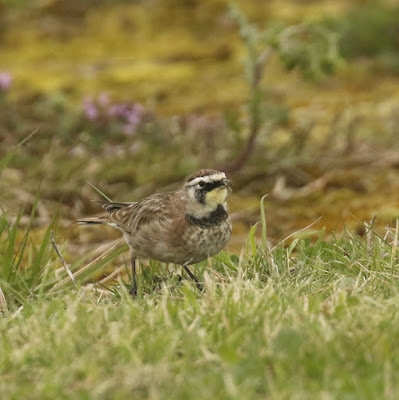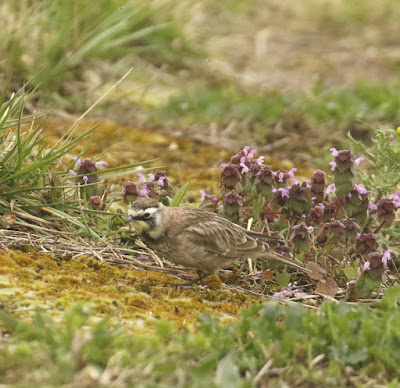Easter Sunday found myself and Moth heading for the outskirts of southwest London for a very strange twitch indeed. Our destination was the affluent suburb of Richmond upon Thames where a Lesser Whitethroat had been discovered, spending the winter in the back gardens of some hugely expensive houses just down the road from Kew Gardens. One particular back garden seemed to be most favoured, in a road called Selwyn Avenue. The back garden was reached by a short and narrow alleyway which served as an access to dustbins and ran around the back of this and the neighbouring gardens.
 |
| The Alley leading to the back of the gardens |
The results of the analysis has subsequently proved this bird to be a Siberian Lesser Whitethroat S.c. blythi, which is a sub species of Lesser Whitethroat.
Parking the car nearby we found the inconspicuous alleyway and walked down it feeling some trepidation and not a little unease about our presence amongst all this conspicuously wealthy housing.To be frank this is the kind of birding I do not particularly relish as I always feel anxious about being so close to homes and potentially invading their privacy but apparently the residents were sanguine about the temporary invasion of birders seeking the Lesser Whitethroat.
 |
| Moth awaiting the arrival of the Lesser Whitethroat |
 |
| Lesser Whitethroat-possibly of eastern race halimodendri |
 |
| Blackcap-male |
We left Richmond at around noon, passing the huge stadium at Twickenham and made our way west to Staines Reservoir which was relatively close by. Our objective was to get a second view of the Horned Lark from North America that has been residing at Staines Reservoir since last November. The last time we visited it was bitterly cold and the views we got were not that great so this time we resolved to try and rectify this.
Today, although cold, it was much calmer and with little wind as we followed the central Causeway to roughly about half way where a small cluster of birders were hanging cameras over the railings obviously looking at and photographing the Horned Lark. Having been here for so long most birders have seen the lark at least once and many, like us, have taken the opportunity to re-visit it.
When we got to the birders, the Horned Lark, almost immediately, flew further along the reservoir bank and for the next few minutes was very flighty indeed, moving up and down and often feeding on the Causeway itself rather than feeding along its usual area on the retaining wall sloping down to the water of the southern basin.
When we got to the birders, the Horned Lark, almost immediately, flew further along the reservoir bank and for the next few minutes was very flighty indeed, moving up and down and often feeding on the Causeway itself rather than feeding along its usual area on the retaining wall sloping down to the water of the southern basin.
 |
| Horned Lark-female |
It was difficult to follow as it scuttled along, hunched over on flexed black legs, vigorously digging out the moss to find any invertebrates hidden beneath. It was rarely still, virtually constantly on the move, but finally it began to show itself more readily and moved away from the concealing vegetation, although it was obvious it was happiest when hidden from view by the various plants springing up all over the moss covered concrete.
The Horned Lark is a female and as such does not have the strong face patterning and obvious feathered horns of a male. Rather its head is a suffusion of yellow and white with ill defined black head and breast markings but with the obvious white forehead and supercilium that mark it out as so different. The rest of the plumage did not seem to have changed much from the last time we saw it. Maybe the breast streaking was a little more sharp and the dark streaks on its unremarkable brown upperparts were stronger.The fore flanks and mantle had also taken on a not unattractive pinkish brown blush.
Its extreme rarity is what makes it so special and guaranteed to attract birders for as long as it remains
Although still considered a sub species of Horned Lark which also includes our confusingly named Shore Lark, it is thought likely to be re-categorized as a separate species sometime in the near future, hence its attraction to birders.
Whatever it is, species or sub species, if accepted it is going to be a first for Britain.
Subsequent DNA analysis from a feather picked up from this bird has confirmed it is one of the American races of Horned Lark.
Its extreme rarity is what makes it so special and guaranteed to attract birders for as long as it remains
Although still considered a sub species of Horned Lark which also includes our confusingly named Shore Lark, it is thought likely to be re-categorized as a separate species sometime in the near future, hence its attraction to birders.
Whatever it is, species or sub species, if accepted it is going to be a first for Britain.
Subsequent DNA analysis from a feather picked up from this bird has confirmed it is one of the American races of Horned Lark.
























No comments:
Post a Comment